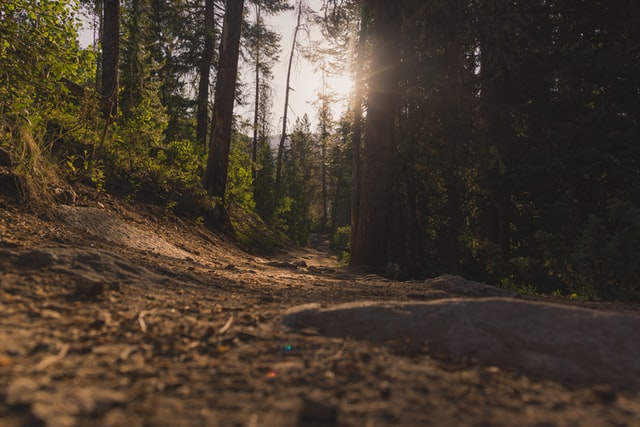
Breckenridge is populated with historic buildings and sites. It features old mines as evidenced by its mining history. Given the rich history in the area, there are plenty of excellent history hiking trails that you can explore on your next trip to Breckenridge, Colorado.
Here are some memorable historic hiking tours we recommend:
Iowa Hill
In Breckenridge, CO, prospectors looked for free gold and found it by gold-panning the stream and river beds. This is a traditional method of extracting the gold by separating it from the other debris. Later on, the hydraulic mining methods replaced the gold panning technique since it was more efficient. It utilizes pressurized water to discover gold on the hillsides.
In the 1860s, Iowa Hill started mining and a range of gold-saving innovative methods can be traced here. One can spot informative signs while hiking the area on your way to the washed-up hillside. Along the way, you’ll find a blacksmith shop, derrick, guardhouse, and shaft. You’ll also see large pipes that were used to blast the mountain when mining was most popular.
Iowa Hill Boarding House
You’ll come upon an original ore cart while walking up the main trail. At the summit of the hill, a boarding house dating back to the 1870s can be seen. You’ll get an idea of the miners’ lifestyle back then when checking the house from the vantage point of the windows.

You also have the option of booking a guided historic tour. It’s provided by Breckenridge Heritage Alliance. When you participate in that tour, you’ll learn information about Iowa Hill as well as get to explore the interior part of the boarding house structure.
Sally Barber
While Breckenridge’s mining is known for gold, silver mines were also operated back in the day. One of these is The Sallie Barber Mine. Back in World War II-era, gold mining ceased as it was deemed nonessential. But the Sallie Barber continued its mining activity and extracted zinc and lead from the shaft.
Around the site, a lot of signs are put up to provide information about the mine’s history and the mining equipment. While heading towards the trail, a rocky area can be spotted where no sign of plant life and soil are seen. This reveals that the area was mined using the hydraulic method similar to Iowa Hill.
It will take 5.5 miles traveling on the loop to finish the Sallie Barber tour. It provides stunning vistas as you wander around the historic trail. Note that motorized vehicles aren’t allowed to pass through it.
Aspen Alley
The hillside presents aspen trees and is one of the best areas to go to during autumn to see the vibrant shades the fall season has to offer. For history enthusiasts, the sight of old lode claims, and steam boilers will excite them as it pinpoints this area as one of the most important mine sites in the past.

Begin exploring the Sawmill Museum to discover more about the producer of beams, posts, and lumber that supported the heyday of the mining industry. You’ll cover 1.5 miles and it ends at the junction with Boreas Pass.
Gold Run Road to the Jessie Mill and Preston Ghost Town
Another mining system was used known as lode mining. It replaced the other forms when the train transport began in 1882. Miners changed their strategy by digging deep into the mountainside. The best thing about having railroads is that heavy equipment can now be imported. It helps when drilling tough rocks to extract the gold.
An excellent Breckenridge mill site is the Jessie Mill. You can find tunnels and giant caverns on the hillside located above the mill. The railroad helped deliver efficiency and produce profits for the mine project.
After Jessie Mill on the Gold Run Road, you’ll reach the ghost town that is Preston. It’s where the Extension Mill is situated. It’s a small-scale model of the Jessie Mill. You’ll see the Portland Filter, a cylindrical-shaped machine that excavates gold using centrifugal force.
In Preston, only a small number of log cabins as well as other structures can be observed here from back when it used to be a thriving town. Preston was vibrant with over a hundred residents, a dress shop, a post office, and a millinery. You can circle back to the Gold Run Road after a 3-mile loop hike. You can also book a guided tour to the Jessie Mill and Preston with the Breckenridge Heritage Alliance.

Reiling Dredge/ B&B Trail/ Minnie Mine Loop
In the 20th century, hydraulic mining became a trend again where gold dredge boats combed through river beds scouting for free gold that is gathered in bedrocks. Rock piles were left by the dredge boats that ran in Breckenridge. At present, The Reiling Dredge still appears undamaged and it was even cleaned up recently.
Wellington Trail to Depression Era Workings
In the 1930s, plenty of workers decided to re-work the old mines and were desperate to find gold. You will find inspiring relics of the mining parts in the Depression-era that can be observed while stationed along the Wellington Trail.
Bottom Line
Breckenridge has a lot of interesting historic hiking trails available to tourists. Those who like to learn more about the cultural aspect of the gold rush era will have a lot of fun times here. If you’re planning a vacation to Breckenridge, Colorado any time soon, consider going on one of these excellent hikes.
If you’re looking for great accommodations during your trip, contact Bighorn Rentals today!
